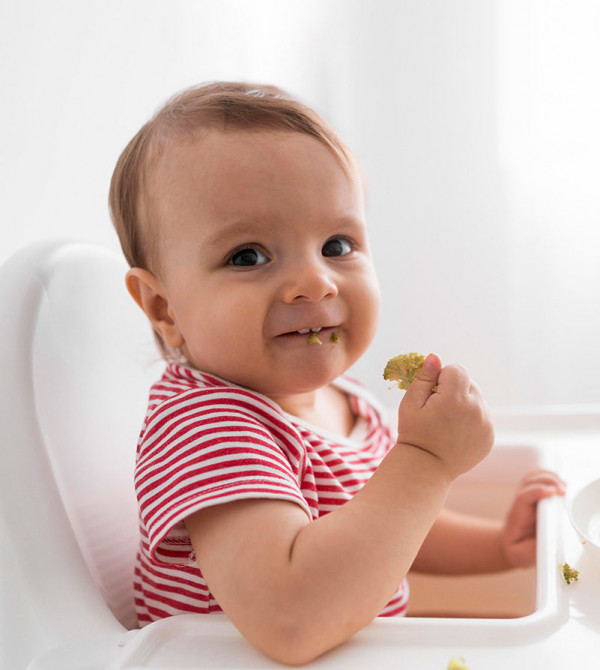
Nutrition from 1 to 3 years
(Almost) eating like a grown-up!
Before the age of 3, discovering tastes is essential for your child to acquire food preferences and the basic rhythms of adults.
But remember that until your child is 3, she will still have specific needs to develop and grow with confidence.

Between the ages of 1 and 2
Her teeth have erupted, she has discovered lots of flavours, and has likes and dislikes. She can eat by herself and use a fork. She can now eat almost anything because her digestive system is more mature.
Your job is to make her discover new tastes, new foods, to introduce her to the basics of a healthy diet and enjoying food, while managing her growing cravings and love of food.
The doctor who follows your child will monitor her growth chart in order to guide you, advise you, and help you make the right choices for your little one as she grows.
How is my baby growing?
Growth charts help you follow the evolution of their weight and height as they grow.

Between the ages of 2 and 3
More milk!
About 500 mL of growing-up milk a day will ensure that you top up her daily nutritional requirements whilst pleasing her.
The “No” stage
Your child is entering a refusal and opposition stage, but your conclusion should not be that she doesn’t like what you are serving. She is testing your resistance to her refusals. This is a normal phase that will be all the more temporary if you continue to offer her the food in other forms.
Take advantage of her curiosity and model this behaviour by eating the same thing with great appetite. At this age, your baby can eat almost anything, although she still has rather specific needs.
Getting the ratio right
Refer to our nutritional guide for menu ideas and a complementary feeding table which provides an overview of foods to introduce by age.
What’s new?
- Raw veg! Vegetables can be added in small pieces, preferably choosing the freshest seasonal produce possible, prepared soon after you have bought or harvested them. Season them with omega-3-rich foods, such as rapeseed or walnut oil. Avoid adding salt so your child does not get into the habit of salty foods.
Good to know: Eating raw vegetables preserves their vitamins and minerals.
Bigger portions!
- Meat: baby goes from 15 to 20g at 9 months (3 level teaspoons) to 25-30g at 1 year (6 level teaspoons), or ½ a hard-boiled egg.
- Dairy products: 3 portions a day: about 500 mL of milk + 1 dairy product (50-125g) + 15-20g of cheese.
The milk and cheese you give your child must always be pasteurised, as babies are still fragile and sensitive to micro-organisms.
Choose unsweetened or low-sugar yoghurt and cottage cheese, adding pieces of fresh fruit instead.
Good to know: Cow’s milk is not yet recommended at this age, since it does not contain enough essential fatty acids, iron, or vitamins, and its protein content is too high.
Emphasise:
- Bread or infant cereals for breakfast to give your child the energy she needs after a long night’s sleep.
- Serve carbohydrates at every meal as grains (rice, porridge), pulses, potatoes, manioc, and bread. Combine this with a portion of vegetables (1/3 carbs for 2/3 veg).
- Fruits and vegetables at every meal: about 5 portions a day, in any form. This is a good habit and taste to keep throughout life.
- Up to 30-40g of meat and fish a day, maximum: focus on leaner cuts. Avoid fatty cured meats, and salty meats. Fish twice a week, alternating between fish with more essential fatty acids, such as salmon, mackerel, sardines, or herring.
Don’t forget to add fats to your baby’s meals (such as butter or an oil, such as rapeseed).
Reduce:
Sweets.
Our answers to your questions
-
At this age, even if her diet is more like yours, growing-up milk is still a crucial food. It is therefore essential for your child to continue drinking 500 mL of growing-up milk a day.
-
These foods are generally too oily, salty, and/or sweet. They are nutritionally worthless, as they mostly have low vitamin and mineral contents. It is therefore a good idea to restrict these to special occasions. Your child will enjoy them even more!
-
Sweets have no nutritional value, but do bring pleasure.
Let your child have a sweet now and then or for special occasions, preferably after meals. -
It is best not to feed your child in between meals. Make sure that they eat enough at mealtimes. If your doctor finds their growth chart normal, there is no need to restrict them, as long as you make sure they are getting a balanced diet. For example, you might increase their vegetable portion, and offer a small piece of bread.
-
Her growth chart is the only valid marker that your doctor will be monitoring. If the doctor says it is normal, that means that your child is eating what she needs. Never force your child to finish and adapt quantities depending on her needs and appetite. It is better to start with small helpings and to serve give your child more as needed.
Baby’s progress

Your baby starts walking, says a few words, expresses wishes.

Your baby only takes one nap now. She eats by herself, but is getting picky and has discovered the power of saying, “no.”

Your baby starts to potty train and can say a few sentences. Her favourite word is “why?”

Your baby is potty training, learning family rules, socialising, and enjoys interacting with people.

Our recipe ideas
France Lait Laboratory has selected a collection of tasty little meals you can cook for your baby.